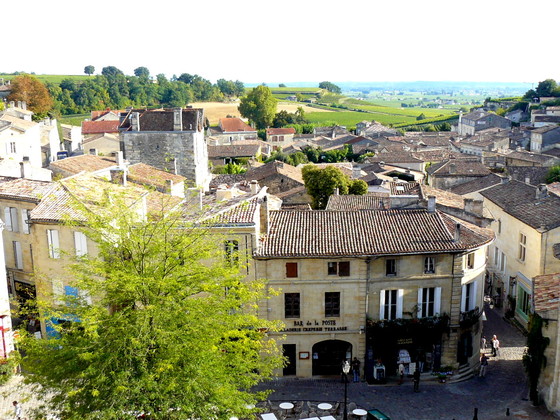
View from the hilltop: vineyards on the limestone slopes produce the best wine.
ST. EMILION, France--This village, 30 miles east of the Bordeaux city limits, encompasses just over 10,000 acres of vineyards (merlot, mostly), where some 70 of the best estates, located on the calcareous plateau overlooking the right bank of the Dordogne River, produce 10 million bottles of wine. It's a tiny part of what is generically called "Bordeaux," in reality a vast region that sends forth 700 million bottles a year, but it's got glamor and history, a couple of super-famous chateaux (Ausone and Cheval Blanc) and this amazing limestone village virtually unchanged since medieval times.
Once a decade, the local growers submit their wines for a ranking. This is virtually unheard of elsewhere in the region; in the Médoc, on the left bank of the river north of Bordeaux, the top châteaux were "classified" in 1855, and that's been that ever since. It was a ranking by market price at the time, and it's held up pretty well, even though it's also something of a self-fulfilling prophecy. But the vineyard owners of Saint Emilion agreed to put themselves through the wringer. The last time they did this, lawsuits flew in all directions, and it took years for the storm to abate. This time, the ranking was done by an independent panel of outsiders (still, all French), and the results are being met with applause.
Best news is that two excellent estates have been promoted to the very top of the classification (Premier Grand Cru Classé A): Pavie and Angélus.
Newcomers to the next notch down, Premier Grand Cru Classé B, were Canon-La-Gaffelière, La Mondotte, Larcis-Ducasse and Valandraud.
The new classification is a sweet victory for Gerard Perse, a supermarket magnate who bought Pavie in 1998 for $38 million. His predecessor, Jean-Paul Valette, was much admired for his consistent, understated style of wine making; Perse, on the other hand, wanted more concentration. In 2003, the year of the drought in Europe, the difference in style was the flashpoint of a controversy when the British wine writer Jancis Robinson wrote:
"Completely unappetising overripe aromas. Why? Porty sweet. Port is best from the Douro not St.Emilion. Ridiculous wine more reminiscent of a late-harvest Zinfandel than a red Bordeaux..."Needless to say, Robert Parker loved the wine. Also needless to say, that's what makes horse racing. If we all liked the same thing, we'd only need one thing.
No comments:
Post a Comment